Tendering Procedures and Contract Types: A Procurement Analysis
VerifiedAdded on 2023/06/16
|9
|2700
|185
Essay
AI Summary
This document presents a detailed analysis of contracts and procurements, focusing on the impact of tendering procedures on price formation in construction contracts and a comparison of two contract types: FICID and NEC. The analysis of tendering methods explores competitive negotiation procedures, market competition's influence on pricing, and the effects on price formulation. The essay on contract types compares FICID and NEC contracts concerning payment conditions, project programming, and dispute resolution methods, highlighting the role of arbitration, mediation, and collaborative law in resolving contractual disputes. The document concludes that understanding these aspects is crucial for effective construction project management and dispute avoidance. Desklib provides access to this and other solved assignments for students.

CONTRACTS & PROCUREMENTS
Paraphrase This Document
Need a fresh take? Get an instant paraphrase of this document with our AI Paraphraser

Contents
CONTRACTS & PROCUREMENTS............................................................................................................1
Critical Analysis of academic journal paper focusing on procurement..................................................3
Impact of tendering procedure on the price formation in construction contracts...............................3
Essay- Two contract types.................................................................................................................5
CONTRACTS & PROCUREMENTS............................................................................................................1
Critical Analysis of academic journal paper focusing on procurement..................................................3
Impact of tendering procedure on the price formation in construction contracts...............................3
Essay- Two contract types.................................................................................................................5
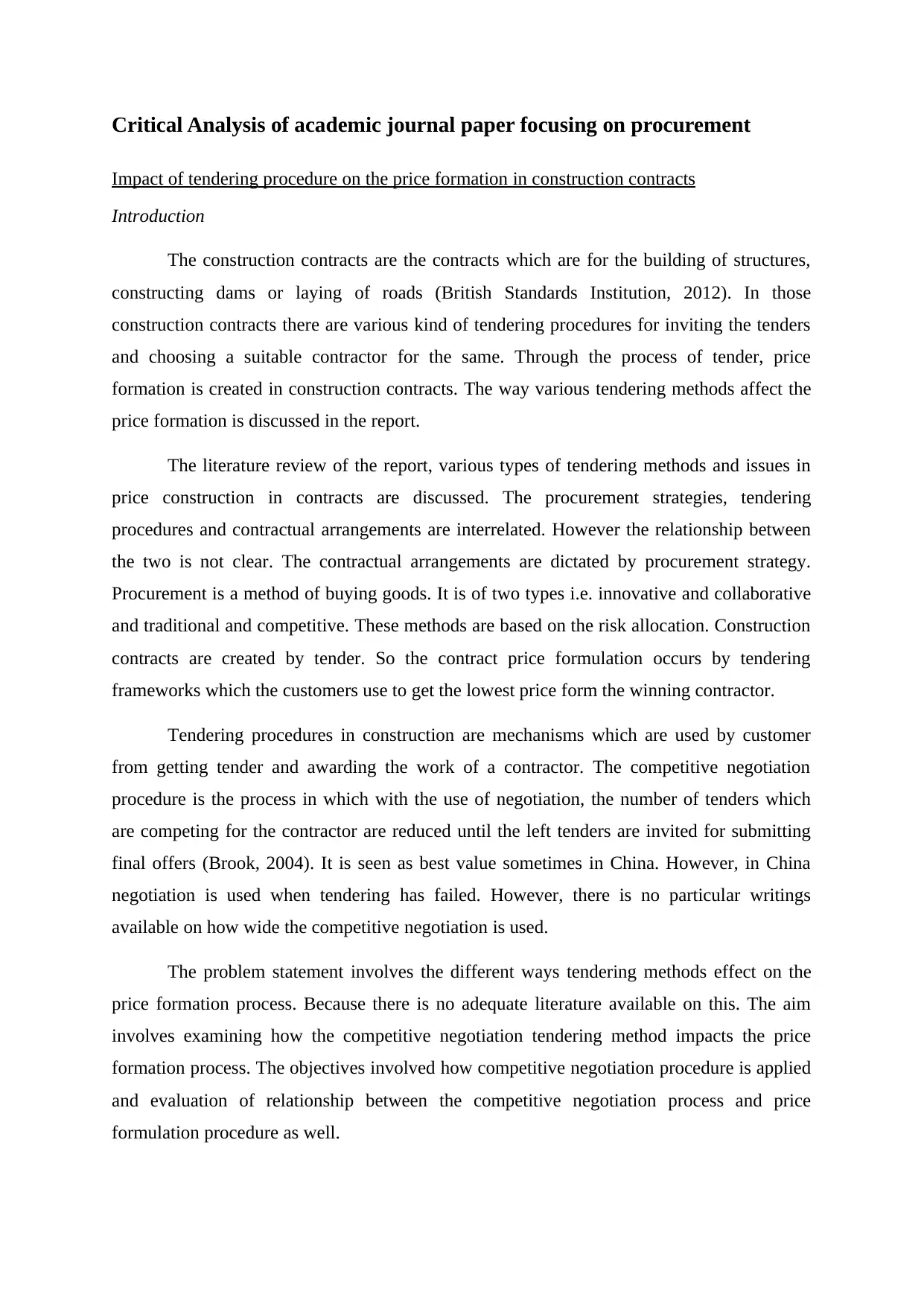
Critical Analysis of academic journal paper focusing on procurement
Impact of tendering procedure on the price formation in construction contracts
Introduction
The construction contracts are the contracts which are for the building of structures,
constructing dams or laying of roads (British Standards Institution, 2012). In those
construction contracts there are various kind of tendering procedures for inviting the tenders
and choosing a suitable contractor for the same. Through the process of tender, price
formation is created in construction contracts. The way various tendering methods affect the
price formation is discussed in the report.
The literature review of the report, various types of tendering methods and issues in
price construction in contracts are discussed. The procurement strategies, tendering
procedures and contractual arrangements are interrelated. However the relationship between
the two is not clear. The contractual arrangements are dictated by procurement strategy.
Procurement is a method of buying goods. It is of two types i.e. innovative and collaborative
and traditional and competitive. These methods are based on the risk allocation. Construction
contracts are created by tender. So the contract price formulation occurs by tendering
frameworks which the customers use to get the lowest price form the winning contractor.
Tendering procedures in construction are mechanisms which are used by customer
from getting tender and awarding the work of a contractor. The competitive negotiation
procedure is the process in which with the use of negotiation, the number of tenders which
are competing for the contractor are reduced until the left tenders are invited for submitting
final offers (Brook, 2004). It is seen as best value sometimes in China. However, in China
negotiation is used when tendering has failed. However, there is no particular writings
available on how wide the competitive negotiation is used.
The problem statement involves the different ways tendering methods effect on the
price formation process. Because there is no adequate literature available on this. The aim
involves examining how the competitive negotiation tendering method impacts the price
formation process. The objectives involved how competitive negotiation procedure is applied
and evaluation of relationship between the competitive negotiation process and price
formulation procedure as well.
Impact of tendering procedure on the price formation in construction contracts
Introduction
The construction contracts are the contracts which are for the building of structures,
constructing dams or laying of roads (British Standards Institution, 2012). In those
construction contracts there are various kind of tendering procedures for inviting the tenders
and choosing a suitable contractor for the same. Through the process of tender, price
formation is created in construction contracts. The way various tendering methods affect the
price formation is discussed in the report.
The literature review of the report, various types of tendering methods and issues in
price construction in contracts are discussed. The procurement strategies, tendering
procedures and contractual arrangements are interrelated. However the relationship between
the two is not clear. The contractual arrangements are dictated by procurement strategy.
Procurement is a method of buying goods. It is of two types i.e. innovative and collaborative
and traditional and competitive. These methods are based on the risk allocation. Construction
contracts are created by tender. So the contract price formulation occurs by tendering
frameworks which the customers use to get the lowest price form the winning contractor.
Tendering procedures in construction are mechanisms which are used by customer
from getting tender and awarding the work of a contractor. The competitive negotiation
procedure is the process in which with the use of negotiation, the number of tenders which
are competing for the contractor are reduced until the left tenders are invited for submitting
final offers (Brook, 2004). It is seen as best value sometimes in China. However, in China
negotiation is used when tendering has failed. However, there is no particular writings
available on how wide the competitive negotiation is used.
The problem statement involves the different ways tendering methods effect on the
price formation process. Because there is no adequate literature available on this. The aim
involves examining how the competitive negotiation tendering method impacts the price
formation process. The objectives involved how competitive negotiation procedure is applied
and evaluation of relationship between the competitive negotiation process and price
formulation procedure as well.
⊘ This is a preview!⊘
Do you want full access?
Subscribe today to unlock all pages.

Trusted by 1+ million students worldwide
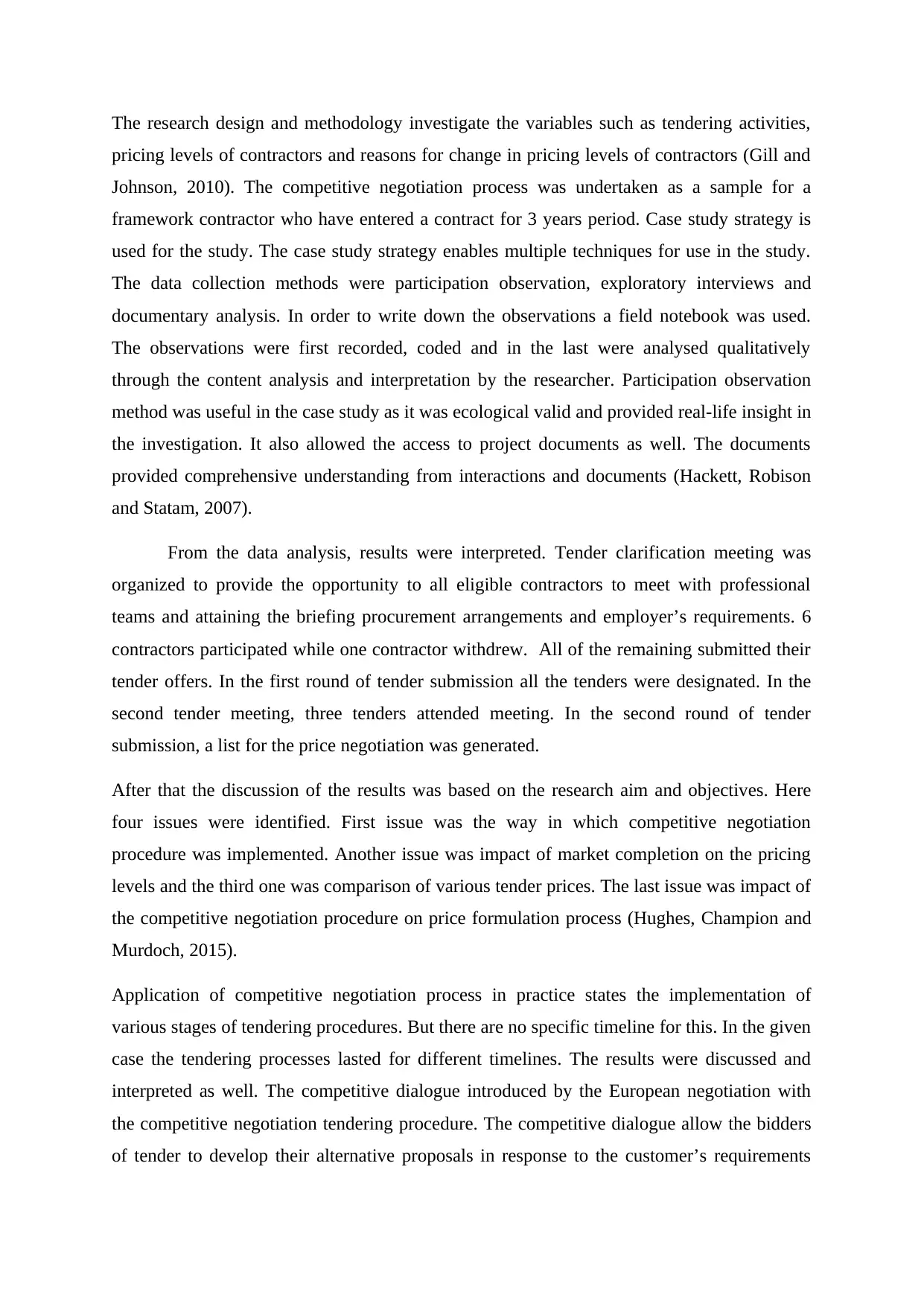
The research design and methodology investigate the variables such as tendering activities,
pricing levels of contractors and reasons for change in pricing levels of contractors (Gill and
Johnson, 2010). The competitive negotiation process was undertaken as a sample for a
framework contractor who have entered a contract for 3 years period. Case study strategy is
used for the study. The case study strategy enables multiple techniques for use in the study.
The data collection methods were participation observation, exploratory interviews and
documentary analysis. In order to write down the observations a field notebook was used.
The observations were first recorded, coded and in the last were analysed qualitatively
through the content analysis and interpretation by the researcher. Participation observation
method was useful in the case study as it was ecological valid and provided real-life insight in
the investigation. It also allowed the access to project documents as well. The documents
provided comprehensive understanding from interactions and documents (Hackett, Robison
and Statam, 2007).
From the data analysis, results were interpreted. Tender clarification meeting was
organized to provide the opportunity to all eligible contractors to meet with professional
teams and attaining the briefing procurement arrangements and employer’s requirements. 6
contractors participated while one contractor withdrew. All of the remaining submitted their
tender offers. In the first round of tender submission all the tenders were designated. In the
second tender meeting, three tenders attended meeting. In the second round of tender
submission, a list for the price negotiation was generated.
After that the discussion of the results was based on the research aim and objectives. Here
four issues were identified. First issue was the way in which competitive negotiation
procedure was implemented. Another issue was impact of market completion on the pricing
levels and the third one was comparison of various tender prices. The last issue was impact of
the competitive negotiation procedure on price formulation process (Hughes, Champion and
Murdoch, 2015).
Application of competitive negotiation process in practice states the implementation of
various stages of tendering procedures. But there are no specific timeline for this. In the given
case the tendering processes lasted for different timelines. The results were discussed and
interpreted as well. The competitive dialogue introduced by the European negotiation with
the competitive negotiation tendering procedure. The competitive dialogue allow the bidders
of tender to develop their alternative proposals in response to the customer’s requirements
pricing levels of contractors and reasons for change in pricing levels of contractors (Gill and
Johnson, 2010). The competitive negotiation process was undertaken as a sample for a
framework contractor who have entered a contract for 3 years period. Case study strategy is
used for the study. The case study strategy enables multiple techniques for use in the study.
The data collection methods were participation observation, exploratory interviews and
documentary analysis. In order to write down the observations a field notebook was used.
The observations were first recorded, coded and in the last were analysed qualitatively
through the content analysis and interpretation by the researcher. Participation observation
method was useful in the case study as it was ecological valid and provided real-life insight in
the investigation. It also allowed the access to project documents as well. The documents
provided comprehensive understanding from interactions and documents (Hackett, Robison
and Statam, 2007).
From the data analysis, results were interpreted. Tender clarification meeting was
organized to provide the opportunity to all eligible contractors to meet with professional
teams and attaining the briefing procurement arrangements and employer’s requirements. 6
contractors participated while one contractor withdrew. All of the remaining submitted their
tender offers. In the first round of tender submission all the tenders were designated. In the
second tender meeting, three tenders attended meeting. In the second round of tender
submission, a list for the price negotiation was generated.
After that the discussion of the results was based on the research aim and objectives. Here
four issues were identified. First issue was the way in which competitive negotiation
procedure was implemented. Another issue was impact of market completion on the pricing
levels and the third one was comparison of various tender prices. The last issue was impact of
the competitive negotiation procedure on price formulation process (Hughes, Champion and
Murdoch, 2015).
Application of competitive negotiation process in practice states the implementation of
various stages of tendering procedures. But there are no specific timeline for this. In the given
case the tendering processes lasted for different timelines. The results were discussed and
interpreted as well. The competitive dialogue introduced by the European negotiation with
the competitive negotiation tendering procedure. The competitive dialogue allow the bidders
of tender to develop their alternative proposals in response to the customer’s requirements
Paraphrase This Document
Need a fresh take? Get an instant paraphrase of this document with our AI Paraphraser
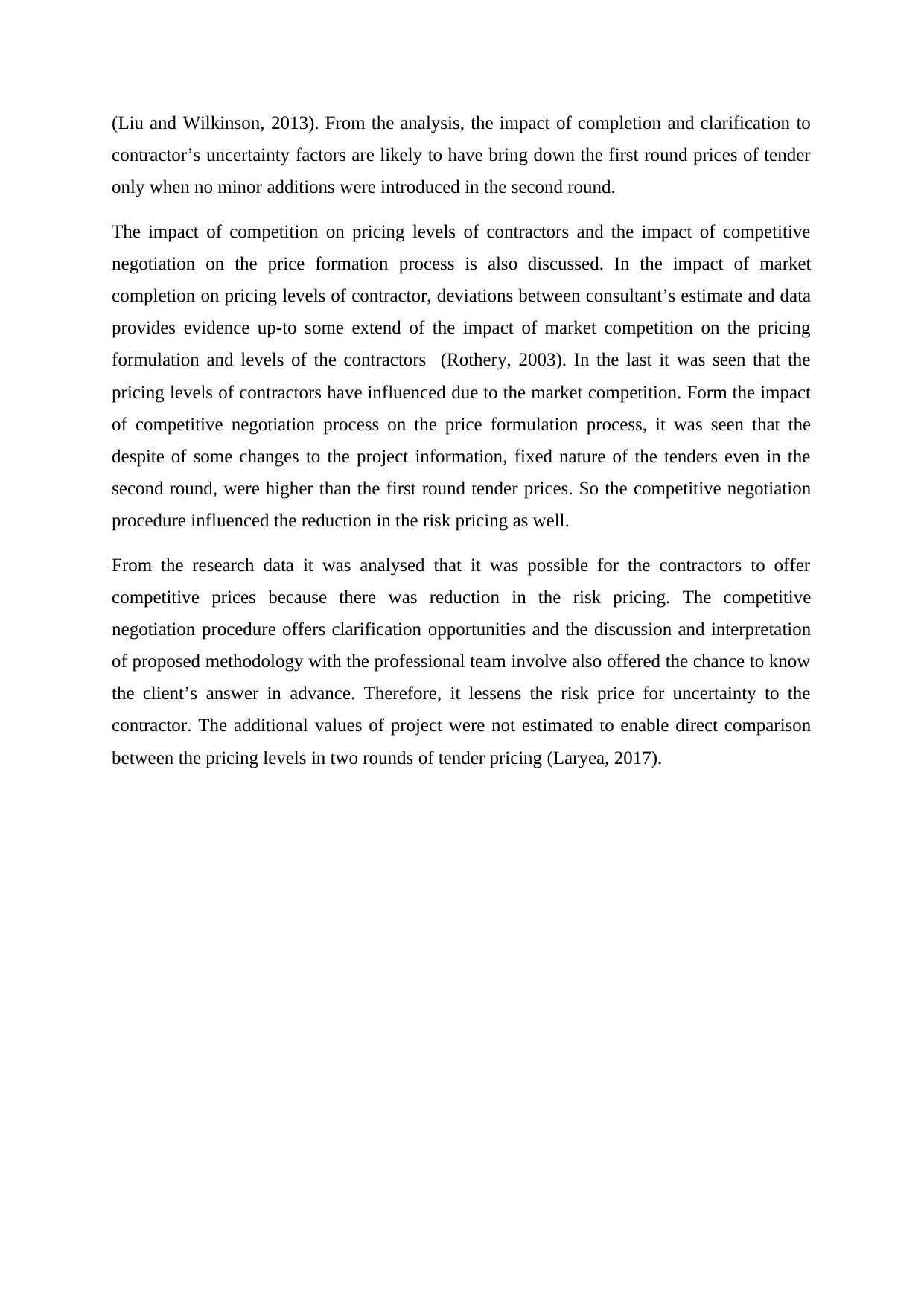
(Liu and Wilkinson, 2013). From the analysis, the impact of completion and clarification to
contractor’s uncertainty factors are likely to have bring down the first round prices of tender
only when no minor additions were introduced in the second round.
The impact of competition on pricing levels of contractors and the impact of competitive
negotiation on the price formation process is also discussed. In the impact of market
completion on pricing levels of contractor, deviations between consultant’s estimate and data
provides evidence up-to some extend of the impact of market competition on the pricing
formulation and levels of the contractors (Rothery, 2003). In the last it was seen that the
pricing levels of contractors have influenced due to the market competition. Form the impact
of competitive negotiation process on the price formulation process, it was seen that the
despite of some changes to the project information, fixed nature of the tenders even in the
second round, were higher than the first round tender prices. So the competitive negotiation
procedure influenced the reduction in the risk pricing as well.
From the research data it was analysed that it was possible for the contractors to offer
competitive prices because there was reduction in the risk pricing. The competitive
negotiation procedure offers clarification opportunities and the discussion and interpretation
of proposed methodology with the professional team involve also offered the chance to know
the client’s answer in advance. Therefore, it lessens the risk price for uncertainty to the
contractor. The additional values of project were not estimated to enable direct comparison
between the pricing levels in two rounds of tender pricing (Laryea, 2017).
contractor’s uncertainty factors are likely to have bring down the first round prices of tender
only when no minor additions were introduced in the second round.
The impact of competition on pricing levels of contractors and the impact of competitive
negotiation on the price formation process is also discussed. In the impact of market
completion on pricing levels of contractor, deviations between consultant’s estimate and data
provides evidence up-to some extend of the impact of market competition on the pricing
formulation and levels of the contractors (Rothery, 2003). In the last it was seen that the
pricing levels of contractors have influenced due to the market competition. Form the impact
of competitive negotiation process on the price formulation process, it was seen that the
despite of some changes to the project information, fixed nature of the tenders even in the
second round, were higher than the first round tender prices. So the competitive negotiation
procedure influenced the reduction in the risk pricing as well.
From the research data it was analysed that it was possible for the contractors to offer
competitive prices because there was reduction in the risk pricing. The competitive
negotiation procedure offers clarification opportunities and the discussion and interpretation
of proposed methodology with the professional team involve also offered the chance to know
the client’s answer in advance. Therefore, it lessens the risk price for uncertainty to the
contractor. The additional values of project were not estimated to enable direct comparison
between the pricing levels in two rounds of tender pricing (Laryea, 2017).
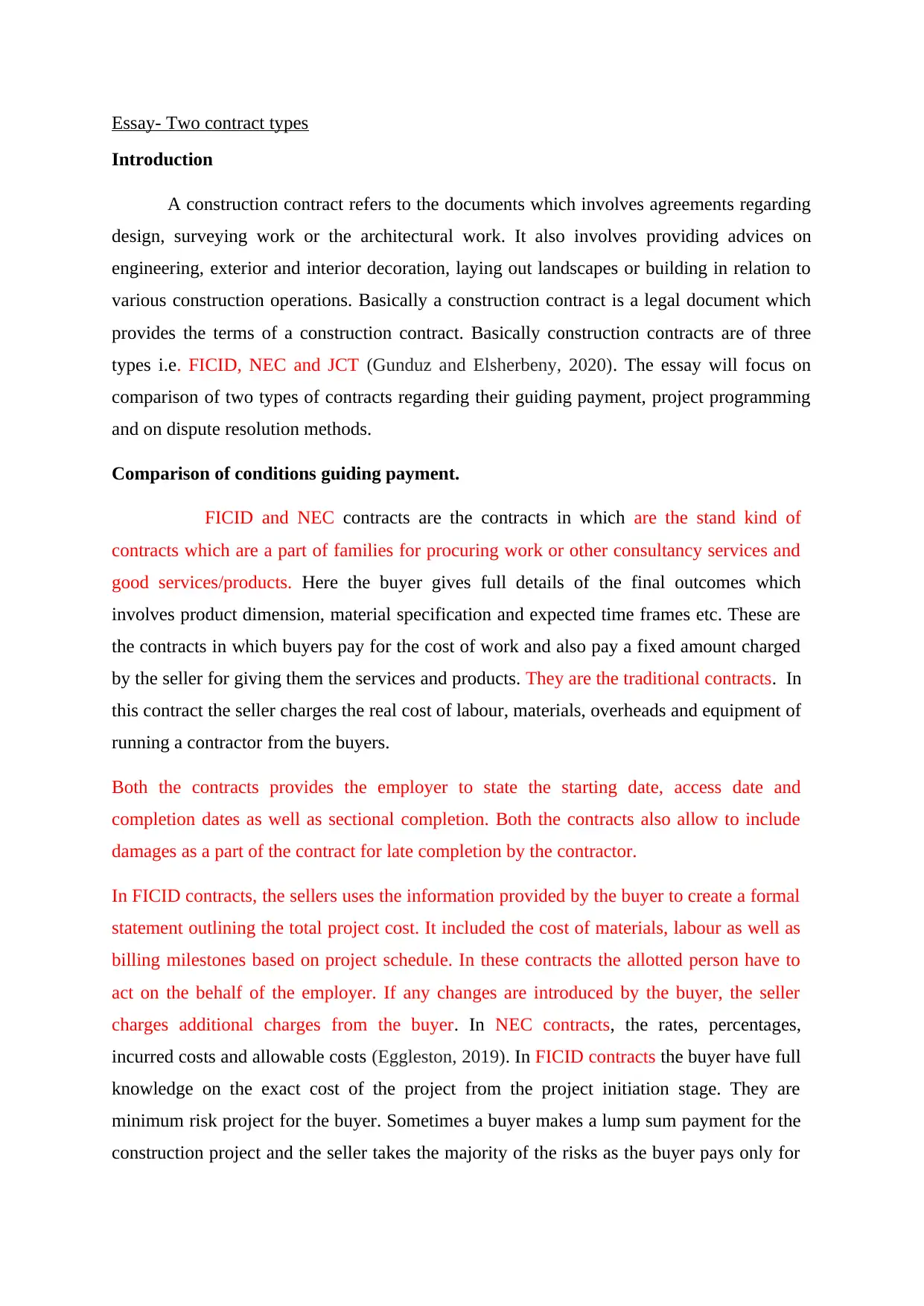
Essay- Two contract types
Introduction
A construction contract refers to the documents which involves agreements regarding
design, surveying work or the architectural work. It also involves providing advices on
engineering, exterior and interior decoration, laying out landscapes or building in relation to
various construction operations. Basically a construction contract is a legal document which
provides the terms of a construction contract. Basically construction contracts are of three
types i.e. FICID, NEC and JCT (Gunduz and Elsherbeny, 2020). The essay will focus on
comparison of two types of contracts regarding their guiding payment, project programming
and on dispute resolution methods.
Comparison of conditions guiding payment.
FICID and NEC contracts are the contracts in which are the stand kind of
contracts which are a part of families for procuring work or other consultancy services and
good services/products. Here the buyer gives full details of the final outcomes which
involves product dimension, material specification and expected time frames etc. These are
the contracts in which buyers pay for the cost of work and also pay a fixed amount charged
by the seller for giving them the services and products. They are the traditional contracts. In
this contract the seller charges the real cost of labour, materials, overheads and equipment of
running a contractor from the buyers.
Both the contracts provides the employer to state the starting date, access date and
completion dates as well as sectional completion. Both the contracts also allow to include
damages as a part of the contract for late completion by the contractor.
In FICID contracts, the sellers uses the information provided by the buyer to create a formal
statement outlining the total project cost. It included the cost of materials, labour as well as
billing milestones based on project schedule. In these contracts the allotted person have to
act on the behalf of the employer. If any changes are introduced by the buyer, the seller
charges additional charges from the buyer. In NEC contracts, the rates, percentages,
incurred costs and allowable costs (Eggleston, 2019). In FICID contracts the buyer have full
knowledge on the exact cost of the project from the project initiation stage. They are
minimum risk project for the buyer. Sometimes a buyer makes a lump sum payment for the
construction project and the seller takes the majority of the risks as the buyer pays only for
Introduction
A construction contract refers to the documents which involves agreements regarding
design, surveying work or the architectural work. It also involves providing advices on
engineering, exterior and interior decoration, laying out landscapes or building in relation to
various construction operations. Basically a construction contract is a legal document which
provides the terms of a construction contract. Basically construction contracts are of three
types i.e. FICID, NEC and JCT (Gunduz and Elsherbeny, 2020). The essay will focus on
comparison of two types of contracts regarding their guiding payment, project programming
and on dispute resolution methods.
Comparison of conditions guiding payment.
FICID and NEC contracts are the contracts in which are the stand kind of
contracts which are a part of families for procuring work or other consultancy services and
good services/products. Here the buyer gives full details of the final outcomes which
involves product dimension, material specification and expected time frames etc. These are
the contracts in which buyers pay for the cost of work and also pay a fixed amount charged
by the seller for giving them the services and products. They are the traditional contracts. In
this contract the seller charges the real cost of labour, materials, overheads and equipment of
running a contractor from the buyers.
Both the contracts provides the employer to state the starting date, access date and
completion dates as well as sectional completion. Both the contracts also allow to include
damages as a part of the contract for late completion by the contractor.
In FICID contracts, the sellers uses the information provided by the buyer to create a formal
statement outlining the total project cost. It included the cost of materials, labour as well as
billing milestones based on project schedule. In these contracts the allotted person have to
act on the behalf of the employer. If any changes are introduced by the buyer, the seller
charges additional charges from the buyer. In NEC contracts, the rates, percentages,
incurred costs and allowable costs (Eggleston, 2019). In FICID contracts the buyer have full
knowledge on the exact cost of the project from the project initiation stage. They are
minimum risk project for the buyer. Sometimes a buyer makes a lump sum payment for the
construction project and the seller takes the majority of the risks as the buyer pays only for
⊘ This is a preview!⊘
Do you want full access?
Subscribe today to unlock all pages.

Trusted by 1+ million students worldwide
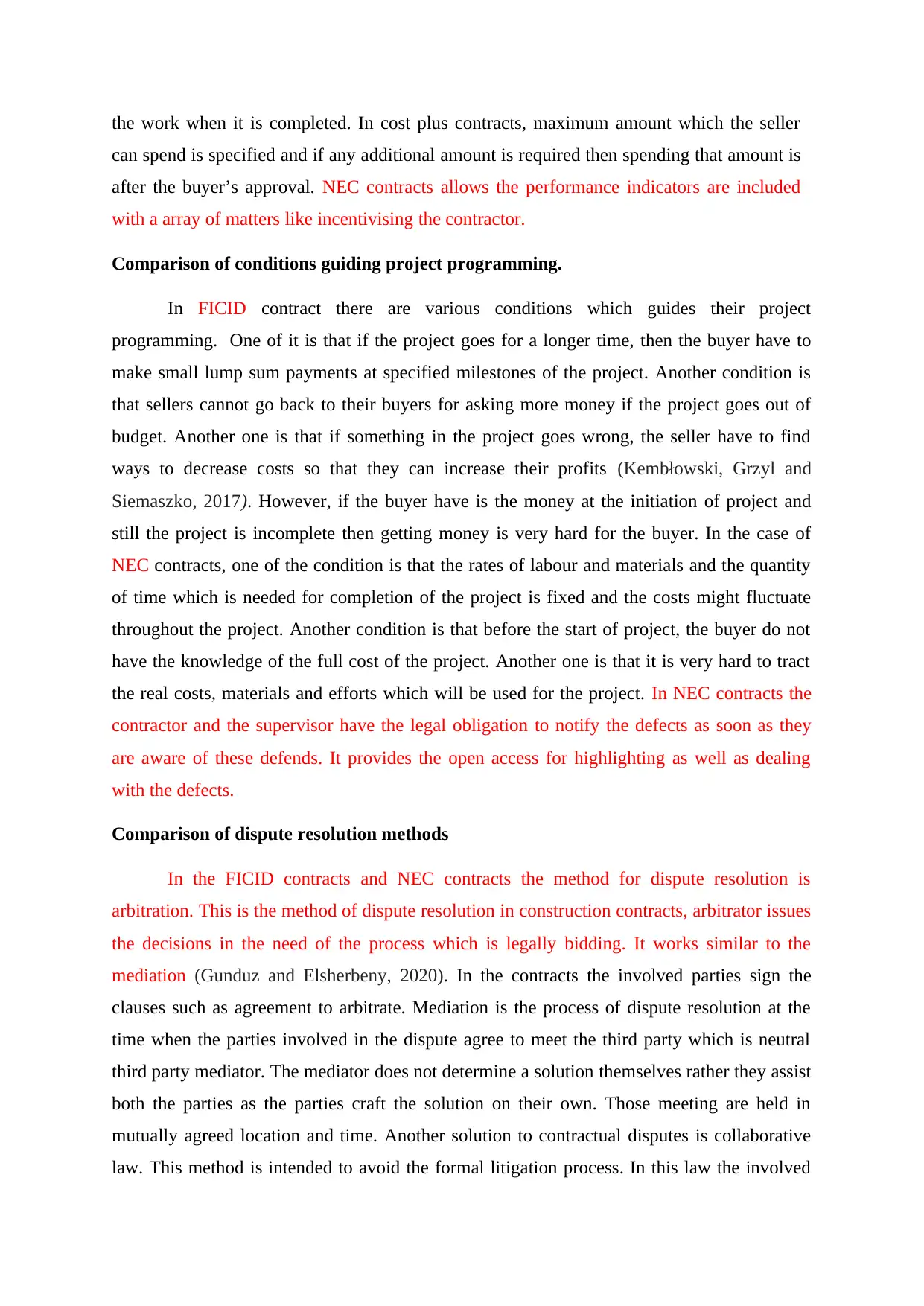
the work when it is completed. In cost plus contracts, maximum amount which the seller
can spend is specified and if any additional amount is required then spending that amount is
after the buyer’s approval. NEC contracts allows the performance indicators are included
with a array of matters like incentivising the contractor.
Comparison of conditions guiding project programming.
In FICID contract there are various conditions which guides their project
programming. One of it is that if the project goes for a longer time, then the buyer have to
make small lump sum payments at specified milestones of the project. Another condition is
that sellers cannot go back to their buyers for asking more money if the project goes out of
budget. Another one is that if something in the project goes wrong, the seller have to find
ways to decrease costs so that they can increase their profits (Kembłowski, Grzyl and
Siemaszko, 2017). However, if the buyer have is the money at the initiation of project and
still the project is incomplete then getting money is very hard for the buyer. In the case of
NEC contracts, one of the condition is that the rates of labour and materials and the quantity
of time which is needed for completion of the project is fixed and the costs might fluctuate
throughout the project. Another condition is that before the start of project, the buyer do not
have the knowledge of the full cost of the project. Another one is that it is very hard to tract
the real costs, materials and efforts which will be used for the project. In NEC contracts the
contractor and the supervisor have the legal obligation to notify the defects as soon as they
are aware of these defends. It provides the open access for highlighting as well as dealing
with the defects.
Comparison of dispute resolution methods
In the FICID contracts and NEC contracts the method for dispute resolution is
arbitration. This is the method of dispute resolution in construction contracts, arbitrator issues
the decisions in the need of the process which is legally bidding. It works similar to the
mediation (Gunduz and Elsherbeny, 2020). In the contracts the involved parties sign the
clauses such as agreement to arbitrate. Mediation is the process of dispute resolution at the
time when the parties involved in the dispute agree to meet the third party which is neutral
third party mediator. The mediator does not determine a solution themselves rather they assist
both the parties as the parties craft the solution on their own. Those meeting are held in
mutually agreed location and time. Another solution to contractual disputes is collaborative
law. This method is intended to avoid the formal litigation process. In this law the involved
can spend is specified and if any additional amount is required then spending that amount is
after the buyer’s approval. NEC contracts allows the performance indicators are included
with a array of matters like incentivising the contractor.
Comparison of conditions guiding project programming.
In FICID contract there are various conditions which guides their project
programming. One of it is that if the project goes for a longer time, then the buyer have to
make small lump sum payments at specified milestones of the project. Another condition is
that sellers cannot go back to their buyers for asking more money if the project goes out of
budget. Another one is that if something in the project goes wrong, the seller have to find
ways to decrease costs so that they can increase their profits (Kembłowski, Grzyl and
Siemaszko, 2017). However, if the buyer have is the money at the initiation of project and
still the project is incomplete then getting money is very hard for the buyer. In the case of
NEC contracts, one of the condition is that the rates of labour and materials and the quantity
of time which is needed for completion of the project is fixed and the costs might fluctuate
throughout the project. Another condition is that before the start of project, the buyer do not
have the knowledge of the full cost of the project. Another one is that it is very hard to tract
the real costs, materials and efforts which will be used for the project. In NEC contracts the
contractor and the supervisor have the legal obligation to notify the defects as soon as they
are aware of these defends. It provides the open access for highlighting as well as dealing
with the defects.
Comparison of dispute resolution methods
In the FICID contracts and NEC contracts the method for dispute resolution is
arbitration. This is the method of dispute resolution in construction contracts, arbitrator issues
the decisions in the need of the process which is legally bidding. It works similar to the
mediation (Gunduz and Elsherbeny, 2020). In the contracts the involved parties sign the
clauses such as agreement to arbitrate. Mediation is the process of dispute resolution at the
time when the parties involved in the dispute agree to meet the third party which is neutral
third party mediator. The mediator does not determine a solution themselves rather they assist
both the parties as the parties craft the solution on their own. Those meeting are held in
mutually agreed location and time. Another solution to contractual disputes is collaborative
law. This method is intended to avoid the formal litigation process. In this law the involved
Paraphrase This Document
Need a fresh take? Get an instant paraphrase of this document with our AI Paraphraser
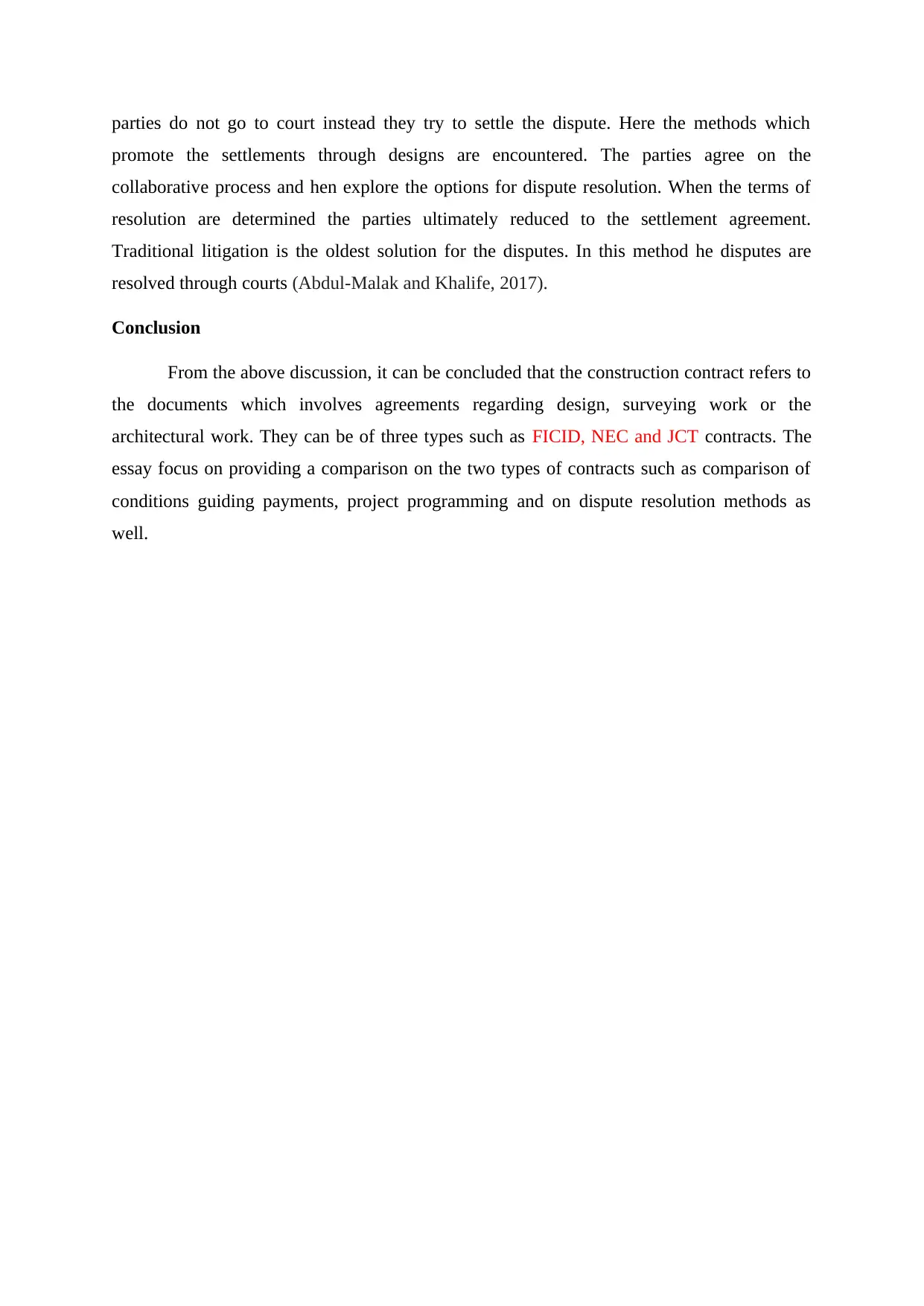
parties do not go to court instead they try to settle the dispute. Here the methods which
promote the settlements through designs are encountered. The parties agree on the
collaborative process and hen explore the options for dispute resolution. When the terms of
resolution are determined the parties ultimately reduced to the settlement agreement.
Traditional litigation is the oldest solution for the disputes. In this method he disputes are
resolved through courts (Abdul-Malak and Khalife, 2017).
Conclusion
From the above discussion, it can be concluded that the construction contract refers to
the documents which involves agreements regarding design, surveying work or the
architectural work. They can be of three types such as FICID, NEC and JCT contracts. The
essay focus on providing a comparison on the two types of contracts such as comparison of
conditions guiding payments, project programming and on dispute resolution methods as
well.
promote the settlements through designs are encountered. The parties agree on the
collaborative process and hen explore the options for dispute resolution. When the terms of
resolution are determined the parties ultimately reduced to the settlement agreement.
Traditional litigation is the oldest solution for the disputes. In this method he disputes are
resolved through courts (Abdul-Malak and Khalife, 2017).
Conclusion
From the above discussion, it can be concluded that the construction contract refers to
the documents which involves agreements regarding design, surveying work or the
architectural work. They can be of three types such as FICID, NEC and JCT contracts. The
essay focus on providing a comparison on the two types of contracts such as comparison of
conditions guiding payments, project programming and on dispute resolution methods as
well.
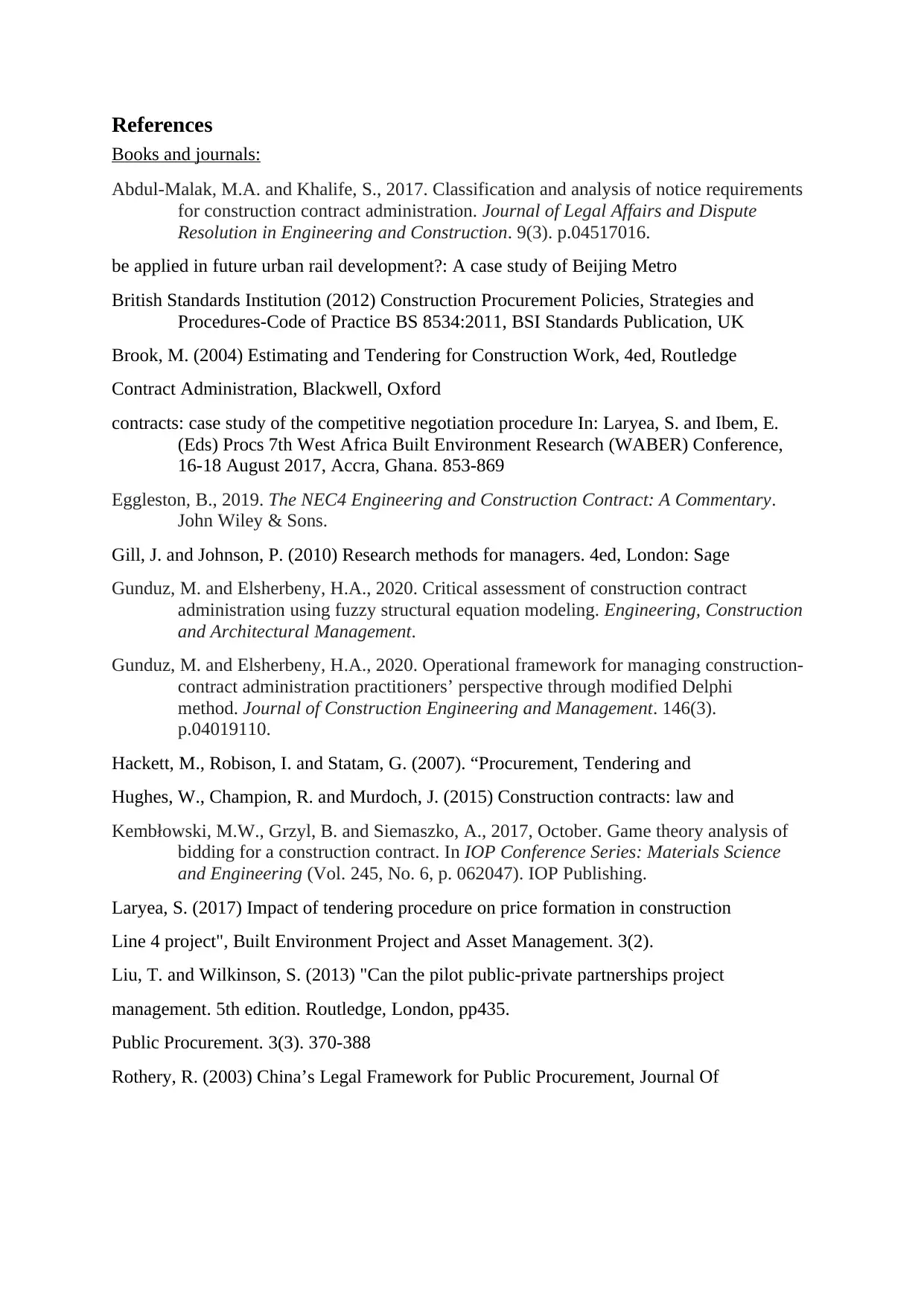
References
Books and journals:
Abdul-Malak, M.A. and Khalife, S., 2017. Classification and analysis of notice requirements
for construction contract administration. Journal of Legal Affairs and Dispute
Resolution in Engineering and Construction. 9(3). p.04517016.
be applied in future urban rail development?: A case study of Beijing Metro
British Standards Institution (2012) Construction Procurement Policies, Strategies and
Procedures-Code of Practice BS 8534:2011, BSI Standards Publication, UK
Brook, M. (2004) Estimating and Tendering for Construction Work, 4ed, Routledge
Contract Administration, Blackwell, Oxford
contracts: case study of the competitive negotiation procedure In: Laryea, S. and Ibem, E.
(Eds) Procs 7th West Africa Built Environment Research (WABER) Conference,
16-18 August 2017, Accra, Ghana. 853-869
Eggleston, B., 2019. The NEC4 Engineering and Construction Contract: A Commentary.
John Wiley & Sons.
Gill, J. and Johnson, P. (2010) Research methods for managers. 4ed, London: Sage
Gunduz, M. and Elsherbeny, H.A., 2020. Critical assessment of construction contract
administration using fuzzy structural equation modeling. Engineering, Construction
and Architectural Management.
Gunduz, M. and Elsherbeny, H.A., 2020. Operational framework for managing construction-
contract administration practitioners’ perspective through modified Delphi
method. Journal of Construction Engineering and Management. 146(3).
p.04019110.
Hackett, M., Robison, I. and Statam, G. (2007). “Procurement, Tendering and
Hughes, W., Champion, R. and Murdoch, J. (2015) Construction contracts: law and
Kembłowski, M.W., Grzyl, B. and Siemaszko, A., 2017, October. Game theory analysis of
bidding for a construction contract. In IOP Conference Series: Materials Science
and Engineering (Vol. 245, No. 6, p. 062047). IOP Publishing.
Laryea, S. (2017) Impact of tendering procedure on price formation in construction
Line 4 project", Built Environment Project and Asset Management. 3(2).
Liu, T. and Wilkinson, S. (2013) "Can the pilot public-private partnerships project
management. 5th edition. Routledge, London, pp435.
Public Procurement. 3(3). 370-388
Rothery, R. (2003) China’s Legal Framework for Public Procurement, Journal Of
Books and journals:
Abdul-Malak, M.A. and Khalife, S., 2017. Classification and analysis of notice requirements
for construction contract administration. Journal of Legal Affairs and Dispute
Resolution in Engineering and Construction. 9(3). p.04517016.
be applied in future urban rail development?: A case study of Beijing Metro
British Standards Institution (2012) Construction Procurement Policies, Strategies and
Procedures-Code of Practice BS 8534:2011, BSI Standards Publication, UK
Brook, M. (2004) Estimating and Tendering for Construction Work, 4ed, Routledge
Contract Administration, Blackwell, Oxford
contracts: case study of the competitive negotiation procedure In: Laryea, S. and Ibem, E.
(Eds) Procs 7th West Africa Built Environment Research (WABER) Conference,
16-18 August 2017, Accra, Ghana. 853-869
Eggleston, B., 2019. The NEC4 Engineering and Construction Contract: A Commentary.
John Wiley & Sons.
Gill, J. and Johnson, P. (2010) Research methods for managers. 4ed, London: Sage
Gunduz, M. and Elsherbeny, H.A., 2020. Critical assessment of construction contract
administration using fuzzy structural equation modeling. Engineering, Construction
and Architectural Management.
Gunduz, M. and Elsherbeny, H.A., 2020. Operational framework for managing construction-
contract administration practitioners’ perspective through modified Delphi
method. Journal of Construction Engineering and Management. 146(3).
p.04019110.
Hackett, M., Robison, I. and Statam, G. (2007). “Procurement, Tendering and
Hughes, W., Champion, R. and Murdoch, J. (2015) Construction contracts: law and
Kembłowski, M.W., Grzyl, B. and Siemaszko, A., 2017, October. Game theory analysis of
bidding for a construction contract. In IOP Conference Series: Materials Science
and Engineering (Vol. 245, No. 6, p. 062047). IOP Publishing.
Laryea, S. (2017) Impact of tendering procedure on price formation in construction
Line 4 project", Built Environment Project and Asset Management. 3(2).
Liu, T. and Wilkinson, S. (2013) "Can the pilot public-private partnerships project
management. 5th edition. Routledge, London, pp435.
Public Procurement. 3(3). 370-388
Rothery, R. (2003) China’s Legal Framework for Public Procurement, Journal Of
⊘ This is a preview!⊘
Do you want full access?
Subscribe today to unlock all pages.

Trusted by 1+ million students worldwide
1 out of 9
Related Documents
Your All-in-One AI-Powered Toolkit for Academic Success.
+13062052269
info@desklib.com
Available 24*7 on WhatsApp / Email
![[object Object]](/_next/static/media/star-bottom.7253800d.svg)
Unlock your academic potential
Copyright © 2020–2025 A2Z Services. All Rights Reserved. Developed and managed by ZUCOL.



